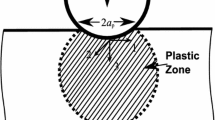Abstract
A theory has been developed for the calculation of relaxation strains effected by drilling a hole in a plate with a linearly varying stress field. With this theory, a technique was developed for the measurement of residual stress at the toe of tee-fillet welds. The above technique was employed for the measurement of residual stresses at the toe of tee-fillet welds in 11/2-in. HY-80 steel with the fillet in the as-welded, ground, shot peened, ground and shot peened, and mechanically peened condition. It was found that experimental data conform to the assumed theory, and that residual stresses in aswelded tee-fillet welds in both the transverse and longitudinal directions approach the yield strength of the steel. It was also found that residual stresses are reduced approximately 25 percent by grinding, 50 percent by shot peening and 50 percent by grinding and shot peening. Mechanical peening drastically affected residual stresses by converting high tension at the toe of the fillet weld to high compression of approximately the same magnitude.
Similar content being viewed by others
Abbreviations
- A :
-
normal stress inx direction at origin, psi
- B :
-
normal stress iny direction at origin, psi
- D :
-
shear stress over entire plate, psi
- E :
-
modulus of elasticity
- F :
-
Airy stress function in Cartesian coordinates
- Re :
-
real part of complex function
- a :
-
radius of drilled hole
- c :
-
stress gradient applicable to\(\sigma _x \), psi/in
- k :
-
stress gradient applicable to\(\sigma _Y \), psi/in
- x, y :
-
Cartesian coordinates
- r, θ:
-
polar coordinates
- z :
-
complex variable,x+iy
- \(\bar z\) :
-
conjugate complex variable,x−iy
- ϕ,X :
-
complex stress functions
- ν:
-
Poisson's ratio
- \(\sigma _x , \sigma _Y \) :
-
normal stresses in Cartesian coordinates, psi
- \(\tau _{XY} \) :
-
shear stress in Cartesian coordinates, psi
- \(\sigma _1 , \sigma _2 \) :
-
principal normal stresses, psi
- \(\sigma _r , \sigma _\theta \) :
-
normal stresses in polar coordinates, ps
- \(\left( { \in _r } \right)R\) :
-
relaxation strain in radial direction, in/in
References
Palermo, P. M., “An Evaluation of the Hole-relaxation Method of Determining Surface Residual Stresses,” Report No. 1742, David Taylor Model Basin (August 1963).
Kelsey, R. A., “Measuring Non-uniform Residual Stresses by the Hole Drilling Method,” Proc. SESA, XIV, 1 (1956).
Rendler, N. J., andVigness, I., “Hole-drilling Strain-gage Method of Measuring Residual Stresses,”Experimental Mechanics,6, (12),577–586 (December,1966).
Cordiano, H. V., and Salerno, V. L., “Fatigue of Structural Elements-Study of Residual Stresses in Linearly Varying Biaxial Stress Fields,” U. S. Naval Applied Science Laboratory, Lab. Project 9300-23, Progress Report No. 2, (April 26, 1967).
Author information
Authors and Affiliations
Additional information
The opinions or assertions contained in this paper are the private ones of the authors and are not to be construed as official or reflecting the views of the Department of the Navy or the Naval service at large.
Rights and permissions
About this article
Cite this article
Cordiano, H.V., Salerno, V.L. Study of residual stresses in linearly varying biaxial-stress fields. Experimental Mechanics 9, 17–24 (1969). https://doi.org/10.1007/BF02327873
Issue Date:
DOI: https://doi.org/10.1007/BF02327873



